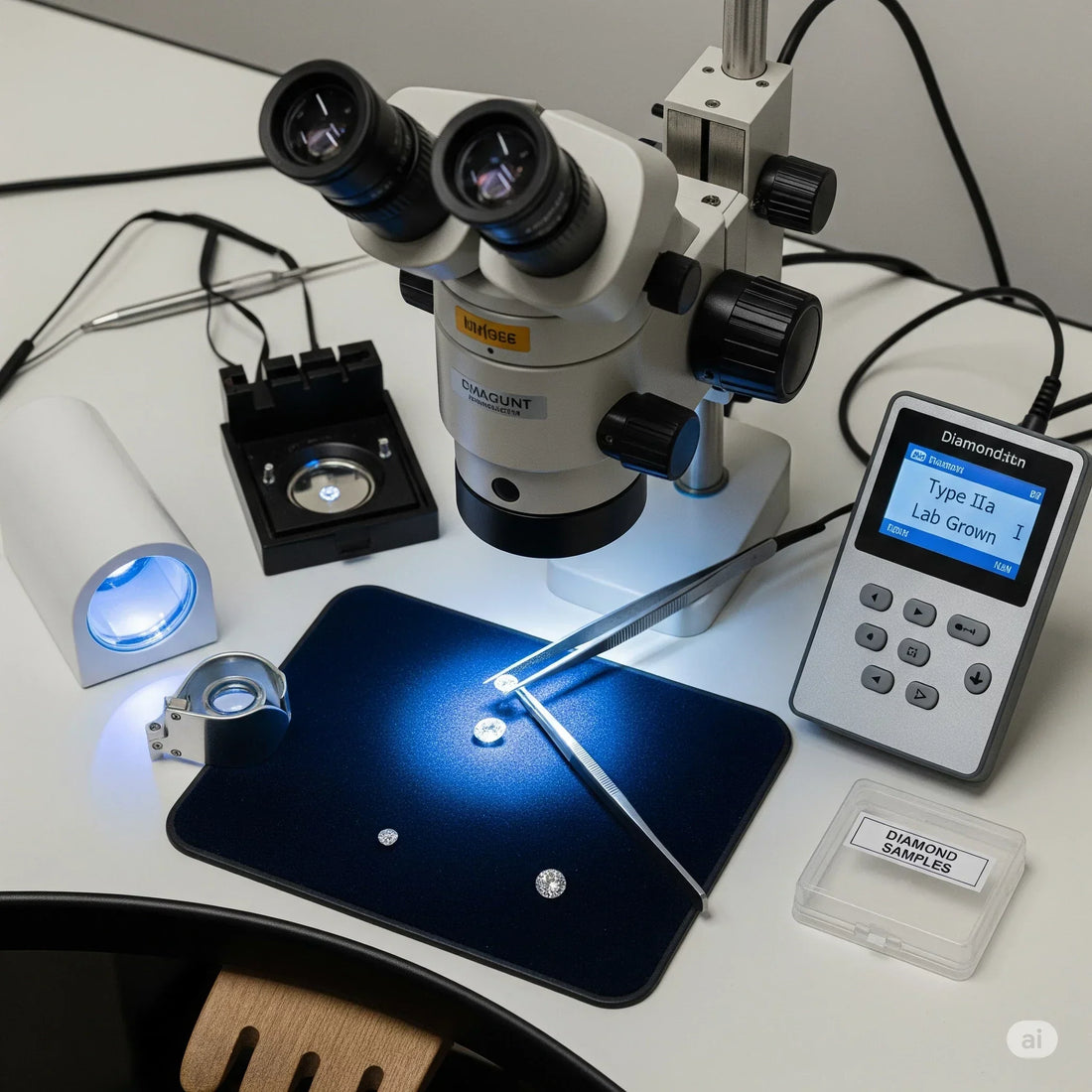
Are Lab Grown Diamonds Real? The Scientific Truth Explained
Chia sẻ
Are Lab Grown Diamonds Real? The Scientific Truth Explained
The question "are lab grown diamonds real" has become increasingly common as more consumers discover these innovative gemstones. The simple answer is yes – lab grown diamonds are absolutely real diamonds, possessing identical physical, chemical, and optical properties to their mined counterparts. This comprehensive guide explores the scientific truth behind lab created diamonds, helping you understand why these gems represent a revolutionary advancement in the jewelry industry.

Are Lab Grown Diamonds Real? Everything You Need to Know / Lab Grown Diamonds vs Natural Diamonds: Complete 2025 Comparison Guide
Understanding Lab Grown Diamonds: The Science Behind Creation
Lab created diamonds are genuine diamonds created in controlled laboratory environments using advanced technological processes that replicate the natural conditions under which diamonds form deep within the Earth. These man made diamonds undergo the same carbon crystallization process that occurs naturally over billions of years, but in a matter of weeks.
The two primary methods for creating lab grown diamonds are:
- High Pressure High Temperature (HPHT): This method recreates the extreme conditions found 100 miles beneath the Earth's surface, using temperatures exceeding 2,000 degrees Fahrenheit and pressures of 1.5 million pounds per square inch.
- Chemical Vapor Deposition (CVD): This process uses a heated chamber filled with carbon-rich gas, where carbon atoms settle onto a diamond seed and gradually build up layers to form a complete diamond crystal.
The Molecular Structure: Identical to Natural Diamonds
At the molecular level, synthetic diamonds are indistinguishable from mined diamonds. Both consist of carbon atoms arranged in the same cubic crystal lattice structure, which gives diamonds their exceptional hardness, brilliance, and fire. This identical composition means lab grown diamonds score 10 on the Mohs hardness scale, just like natural diamonds.

Lab Grown vs. Natural Diamonds: A Comprehensive Comparison
When examining whether are lab grown diamonds real, it's essential to understand how they compare to natural diamonds across various characteristics:
Physical Properties
Lab created diamonds and natural diamonds share identical physical properties:
- Hardness: Both score 10 on the Mohs scale
- Refractive Index: 2.42 for both types
- Density: 3.52 g/cm³ for both
- Thermal Conductivity: Identical heat conduction properties
Optical Properties
The brilliance, fire, and scintillation of man made diamonds match those of natural diamonds perfectly. Both types exhibit the same light performance characteristics that make diamonds so captivating.
Chemical Composition
Both lab grown and natural diamonds are pure carbon (C) arranged in a diamond crystal structure. The only differences lie in trace elements that may be present, which can sometimes help gemologists distinguish between the two using specialized equipment.

The Certification and Grading Process
Major gemological institutes, including the Gemological Institute of America (GIA) and the International Gemological Institute (IGI), grade synthetic diamonds using the same 4Cs criteria applied to natural diamonds:
Cut Quality
Lab created diamonds can be cut to the same precision standards as natural diamonds, achieving excellent cut grades that maximize brilliance and fire.
Color Grading
The color grading scale from D (colorless) to Z (light yellow) applies equally to lab grown diamonds. Many lab created diamonds achieve higher color grades than natural diamonds due to controlled growing conditions.
Clarity Assessment
Clarity grades from Flawless (FL) to Included (I3) are determined using identical standards for both diamond types. Lab grown diamonds often exhibit fewer inclusions than natural diamonds.
Carat Weight
Lab grown diamonds are measured and priced by carat weight using the same standards as natural diamonds.

Advantages of Choosing Lab Grown Diamonds
Understanding why are lab grown diamonds real leads to recognizing their numerous advantages:
Environmental Benefits
Lab created diamonds require significantly less environmental disruption than traditional diamond mining. They eliminate the need for large-scale excavation, reducing habitat destruction and minimizing carbon footprint.
Ethical Considerations
Lab grown diamonds provide a conflict-free alternative, ensuring your purchase doesn't contribute to unethical mining practices or fund conflicts in diamond-producing regions.
Value Proposition
Man made diamonds typically cost 30-40% less than comparable natural diamonds, allowing consumers to purchase larger or higher-quality stones within their budget.
Quality Consistency
The controlled laboratory environment allows for consistent quality production, often resulting in diamonds with fewer inclusions and better color grades than natural alternatives.

Common Misconceptions About Lab Grown Diamonds
Several myths persist about synthetic diamonds that need clarification:
Myth: Lab Grown Diamonds Are Fake
Truth: Lab created diamonds are real diamonds with identical properties to natural diamonds. The Federal Trade Commission recognizes them as genuine diamonds.
Myth: They Don't Hold Value
Truth: While lab grown diamonds may have different resale characteristics than natural diamonds, they maintain intrinsic value based on their beauty and durability.
Myth: They're Easy to Detect
Truth: Only specialized gemological equipment can reliably distinguish between lab grown and natural diamonds. They're visually identical to the naked eye.
Myth: They're Lower Quality
Truth: Lab grown diamonds often exhibit superior quality characteristics due to controlled growing conditions.
How to Identify Lab Grown Diamonds
While consumers cannot visually distinguish between lab created diamonds and natural diamonds, professional identification methods include:
Gemological Testing
Professional gemologists use specialized equipment such as:
- Photoluminescence spectroscopy
- DiamondSure and DiamondView instruments
- Advanced spectroscopic analysis
Certification Disclosure
Reputable sellers always disclose when diamonds are lab grown, and certificates clearly indicate the diamond's origin.
Laser Inscriptions
Many synthetic diamonds feature microscopic laser inscriptions on the girdle identifying them as lab created.

The Future of Lab Grown Diamonds
The lab grown diamond industry continues evolving rapidly, with technological advances improving quality and reducing production costs. Market acceptance grows as consumers recognize that are lab grown diamonds real diamonds offering exceptional value and ethical benefits.
Technological Improvements
Ongoing research focuses on:
- Faster production methods
- Larger diamond creation capabilities
- Enhanced color and clarity control
- Reduced production costs
Market Trends
Industry projections indicate continued growth in lab grown diamond adoption, particularly among younger consumers who prioritize sustainability and value.
Choosing the Right Lab Grown Diamond
When selecting lab created diamonds, consider these factors:
Certification Requirements
Always purchase certified lab grown diamonds from reputable grading institutes. Proper certification ensures quality and authenticity.
Setting Considerations
Man made diamonds work beautifully in all jewelry settings, from classic solitaires to elaborate vintage designs. Their durability makes them suitable for everyday wear.
Budget Planning
The cost savings of lab grown diamonds allow for upgrades in size, quality, or setting complexity while maintaining budget constraints.
Personal Preferences
Consider your priorities regarding environmental impact, ethical sourcing, and value when making your decision.

Care and Maintenance
Synthetic diamonds require the same care as natural diamonds:
Regular Cleaning
Clean your lab grown diamonds regularly using:
- Warm soapy water and soft brush
- Professional ultrasonic cleaners
- Steam cleaning (when appropriate)
Professional Maintenance
Schedule annual professional inspections to ensure settings remain secure and diamonds maintain their brilliance.
Storage Guidelines
Store lab created diamonds separately to prevent scratching, using individual pouches or compartments.
Investment Considerations
When evaluating are lab grown diamonds real investments, consider:
Market Dynamics
Lab grown diamond prices continue stabilizing as production scales and market acceptance grows.
Long-term Value
While resale markets differ from natural diamonds, lab grown diamonds retain value based on their inherent beauty and utility.
Personal Satisfaction
The primary value lies in personal enjoyment and the knowledge that your purchase aligns with ethical and environmental values.
Frequently Asked Questions
Are lab grown diamonds as durable as natural diamonds?
Yes, lab created diamonds possess identical hardness and durability to natural diamonds, scoring 10 on the Mohs scale and suitable for daily wear.
Can jewelers tell the difference between lab grown and natural diamonds?
Professional jewelers require specialized equipment to distinguish between the two types. Visual inspection alone cannot reliably identify the difference.
Do lab grown diamonds come with warranties?
Reputable sellers provide warranties on man made diamonds similar to those offered for natural diamonds, covering manufacturing defects and quality issues.
Are lab grown diamonds available in all shapes and sizes?
Yes, synthetic diamonds can be created in all popular shapes and various sizes, though extremely large stones may be less common than smaller ones.
How long does it take to create a lab grown diamond?
Depending on size and method, lab grown diamonds typically require 2-4 weeks to create, compared to billions of years for natural formation.
Do lab grown diamonds have inclusions like natural diamonds?
Lab created diamonds can have inclusions, though they're often different types than those found in natural diamonds and frequently fewer in number.
Are lab grown diamonds more environmentally friendly?
Yes, lab grown diamonds require significantly less environmental disruption than traditional mining, with lower carbon footprints and no habitat destruction.
Can lab grown diamonds be insured?
Insurance companies treat synthetic diamonds similarly to natural diamonds, providing coverage based on certified value and replacement cost.

Making Your Decision: Lab Grown Diamond Purchase Guide
When you understand that are lab grown diamonds real diamonds offering exceptional value, the decision process becomes clearer. Consider these final factors:
Quality Assessment
Evaluate lab created diamonds using the same criteria as natural diamonds, focusing on the 4Cs and overall beauty.
Seller Reputation
Choose established retailers with transparent policies, proper certifications, and excellent customer service records.
Return Policies
Ensure your purchase includes reasonable return policies and satisfaction guarantees.
Future Considerations
Think about long-term satisfaction, maintenance requirements, and how the diamond fits your lifestyle and values.
Ready to Discover the Beauty of Lab Grown Diamonds?
Now that you understand the scientific truth that lab created diamonds are genuine diamonds with identical properties to natural stones, you're equipped to make an informed decision. These remarkable gems offer the perfect combination of beauty, value, and ethical sourcing that today's conscious consumers demand.
Whether you're shopping for an engagement ring, anniversary gift, or personal jewelry collection, man made diamonds provide an exceptional opportunity to own stunning diamonds while supporting sustainable practices. The question isn't whether lab grown diamonds are real – science has definitively answered that they are. The question is whether you're ready to embrace this innovative approach to diamond ownership.
Take the next step in your diamond journey today. Explore our collection of certified lab grown diamonds and discover how these scientifically identical gems can exceed your expectations while aligning with your values. Contact our diamond experts for personalized guidance in selecting the perfect synthetic diamonds for your needs, and experience firsthand why lab grown diamonds represent the future of fine jewelry.
Don't let outdated misconceptions prevent you from discovering the beauty, value, and peace of mind that come with choosing lab grown diamonds. Your perfect diamond awaits – one that's real in every sense that matters.
